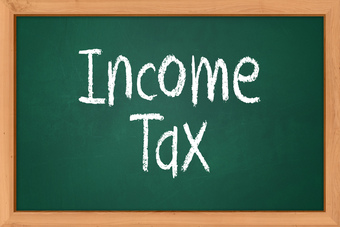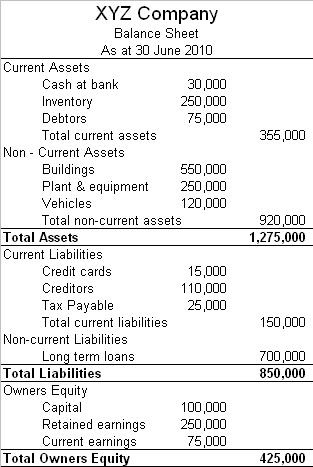15.1: Income Tax Accounting
15.1.1: Overview of Income Tax Accounting
There is a difference between Internal Revenue Service code and generally accepted accounting principles for reporting tax liability.
Learning Objective
Summarize how to account for deferred taxes under the deferred method and the asset-liability method
Key Points
- Taxable income a company reports to the IRS may not be the same as the pre-tax profit reported on its financial statements.
- The actual amount of tax liability due to the IRS may not be the same as the income tax expense reported on the income statement.
- Temporary difference: the book income (income shown on the company financials) may be higher one year, but lower in future years. Thus, the cumulative profit will be the same for both.
- Permanent difference: Due to generally accepted accounting principles, treating items, such as income and expenses, differently than the IRS, the difference may never reverse.
- If a company realizes a net loss for tax purposes, the IRS allows the company to offset this loss against the prior year’s taxable income (which could result in a refund of taxes paid in prior periods).
- In the asset-liability method, deferred income tax amount is based on the expected tax rates for the periods in which the temporary differences reverse. It is a balance-sheet-oriented approach. This method is the only one accepted by GAAP.
Key Terms
- deferred
-
Of or pertaining to a value that is not realized until a future date (e.g., annuities, charges, taxes, income, either as an asset or liability.
- deduct
-
To take one thing from another; remove from; make smaller by some amount.
Income Tax Reporting
In order to properly account for income taxes, it is important to understand that the Internal Revenue Service code that governs accounting for tax liability isn’t the same as the generally accepted accounting principles (GAAP) for reporting tax liability on the financial statements.

Income Tax
Reporting income tax is complicated by the fact that IRS code differs from generally accepted accounting principles
The result is the taxable income a company reports to the IRS may not be the same as the pre-tax profit reported on its financial statements.
Also, the actual amount of tax liability due to the IRS may not be the same as the income tax expense reported on the income statement.
The differences in what is reported on the financials and what is reported to the IRS are divided into two classifications, temporary difference and permanent difference.
Temporary difference: The book income (income shown on the company financials) may be higher one year, but lower in future years. Thus, the cumulative profit will be the same for both.
Permanent difference: Due to generally accepted accounting principles treating items such as income and expenses differently than the IRS, the difference may never reverse.
Accounting for Deferred Taxes
Deferred Method
In this method, the deferred income tax amount is based on tax rates in effect when the temporary differences originated. The deferred method is an income-statement-oriented approach. This method seeks to properly match expenses with revenues in the period the temporary difference originated. Note this method is notacceptable under GAAP.
Asset-liability Method
In the asset-liability method, deferred income tax amount is based on the expected tax rates for the periods in which the temporary differences reverse. It is a balance-sheet-oriented approach. This method is the only one accepted by GAAP.
Future Taxable Amounts, Future Deductible Amounts and Net Operating Loss
Loss Carry Backs and Loss Carry Forwards
Under U.S. Federal income tax law, a net operating loss (NOL) occurs when certain tax-deductible expenses exceed taxable revenues for a taxable year.
If a company realizes a net loss for tax purposes, the IRS allows the company to offset this loss against prior year’s taxable income (which could result in a refund of taxes paid in prior periods).
The company may carry those losses back three years. If the company doesn’t have the sufficient taxable income in the past three years to absorb the loss, then it may carry the remaining losses forward for 15 years. This allows the company to deduct the loss against future taxable income.
15.2: Pension Accounting
15.2.1: Overview of Pension Accounting
A pension is a contract for a fixed sum to be paid regularly to a person, typically following retirement from service.
Learning Objective
Summarize how a company reports their pension plan on their financials statements
Key Points
- The two most common are the defined benefit and the defined contribution plan.
- The employer (sponsor) reports pension expense on the income statement, and a pension liability which is the sum of two accounts, accrued/prepaid pension cost and additional liability, and an intangible asset-deferred pension cost (if required).
- In a defined contribution plan (such as a 401k), while the company makes contributions or matching contributions, it does not promise the future benefit to the employee.
Key Terms
- pension
-
A regularly paid gratuity paid regularly as benefit due to a person in consideration of past services; notably to one retired from service, on account of retirement age, disability, or similar cause; especially, a regular stipend paid by a government to retired public officers, disabled soldiers; sometimes passed on to the heirs, or even specifically for them, as to the families of soldiers killed in service.
- contribution
-
An amount of money given toward something.
Components of a Pension Plan
A pension is a contract for a fixed sum to be paid regularly to a person, typically following retirement from service.
Types of Pension Plans
While there are various pension plans in use today, the two most common are the defined benefit and the defined contribution plan.
With a defined benefit plan, an employee knows the terms of the benefit to be received upon retirement. So, the company must invest in a fund in order to meet its obligations to the employee. In this type of plan the company bears the investment risk.
In a defined contribution plan (such as a 401k), while the company makes contributions or matching contributions, it does not promise the future benefit to the employee. In such a plan, the employee bears the investment risk.

A 401k is a defined contribution plan
In a defined contribution plan the employees bear all the risk.
Pension Plan Accounting
Due to the nature of pension plans, accounting for them is rather complicated. The first complication is that pension benefits are payable to retirees in the far future, so it is hard to estimate the amount of future payments.
The second complication comes from the application of accrual accounting. Since, the actual cash flows are not counted each year; this means the annual pension expense is based on rules that attempt to capture changing assumptions about the future.
The last complication comes from the rules that require companies to prevent over/under stating the pension funds. This smoothing out of the account disguises the true position of the plan.
The employer (sponsor) reports pension expense on the income statement, and a pension liability which is the sum of two accounts, accrued/prepaid pension cost and additional liability, and an intangible asset-deferred pension cost (if required).
The employer is also required to maintain memo accounts for unrecognized prior service costs and unrecognized gains and losses.
How a Pension Plan Is Presented in the Financials
In addition to reporting the pension expense on the income statement companies should disclose the following information about the pension plan:
- Plan description (including benefit formula, employee groups covered, funding policy. and types of assets held)
- The amounts for the components of pension expense for the period
- A reconciliation schedule relating the funding status of the plan
15.3: Lease Accounting
15.3.1: Overview of Lease Accounting
There are two types of leases: capital leases and operating leases and each has a different accounting methodology.
Learning Objective
Summarize how a company would account for a lease
Key Points
- A lease allows a company to get a major piece of equipment with no large expenditure of cash.
- A capital lease is a form of debt-equity financing in which the lease acts like loan.
- An operating lease lets a company obtain equipment with virtually no upfront capital outlay and with the lease payments treated as a deductible cost of business.
Key Terms
- monetary
-
Of, pertaining to, or consisting of money.
- capital lease
-
a financial arrangement where the borrower uses an asset and pays regular installments plus interest
- lessor
-
The owner of property that is leased.
- expenditure
-
An amount expended; an expense; an outlay.
What is a Lease
A lease is a contract calling for the lessee (user) to pay the lessor (owner) for use of an asset for a specified period.
Why Do Some Companies Lease
For many companies the decision is monetary. A lease allows a company to get a major piece of equipment with no large expenditure of cash. In addition, some companies who are in the financial position to buy equipment still prefer to lease because they would not benefit from the depreciation on the equipment.

Equipment Lease
An equipment lease allows a company to get a piece of equipment without a large expenditure.
Types of Leases
There are two types of leases capital leases and operating leases.
Capital equipment is financed either with debt or equity. A capital lease is a form of debt-equity financing in which the lease acts like loan. To that end, a capital lease must be recorded as liability on the company’s balance sheet, it is important to note that the IRS treats capital leases as a liability.
On the other hand, an operating lease lets a company obtain equipment with virtually no upfront capital outlay and with the lease payments treated as a deductible cost of business.
Accounting for the Lease-Leasee
Under an operating lease, the lessee records rent expense (debit) over the lease term, and a credit to either cash or rent payable. If an operating lease has scheduled changes in rent, normally the rent must be registered as an expense on a straight-line basis over its life, with a deferred liability or asset reported on the balance sheet for the difference between expense and cash outlay.
Under a capital lease, the lessee does not record rent as an expense. Instead, the rent is reclassified as interest and obligation payments, similarly to a mortgage (with the interest calculated each rental period on the outstanding obligation balance). At the same time, the asset is depreciated. If the lease has an ownership transfer or bargain purchase option, the depreciable life is the asset’s economic life; otherwise, the depreciable life is the lease term. Over the life of the lease, the interest and depreciation combined will be equal to the rent payments.
Note: For both capital and operating leases, a separate footnote to the financial statements discloses the future minimum rental commitments, by year for the next five years, then all remaining years as a group.
Accounting for the Lease-Lessor
Under an operating lease, the lessor records rent revenue (credit) and a corresponding debit to either cash/rent receivable. The asset remains on the lessor’s books as an owned asset. The lessor records depreciation expense over the life of the asset. Under a capital lease, the lessor credits owned assets and debits a lease-receivable account for the present value of the rents. The rents are an asset, which is broken out between current and long-term, the latter being the present value of rents due more than 12 months in the future. With each payment, cash is debited, the receivable is credited, and unearned (interest) income is credited.
Other Lease Items
- Leasehold Improvements: Improvements made by the lessee. These are permanently affixed to the property and revert to the lessor at the termination of the lease. The value of the leasehold improvements should be capitalized and depreciated over the lesser of the lease life or the leasehold improvements life. If the life of the leasehold improvement extends past the life of the initial term of the lease and into an option period, normally that option period must be considered part of the life of the lease.
- Lease Bonus: Prepayment for future expenses. Classified as an asset; amortized using the straight-line method over the life of the lease.
- Security Deposits: Nonrefundable security deposits:deferred by the lessor as unearned revenue; capitalized by the lessee as a prepaid rent expense until the lessor considers the deposit earned. Refundable security deposits: treated as a receivable by the lessee; treated as a liability by the lessor until the deposit is refunded to the lessee.
15.4: Making Changes and Correcting Errors
15.4.1: Overview of Statement Changes and Errors
Despite best efforts, occasionally an error is made on the financial statement and must be corrected.
Learning Objective
Explain why a previously issued financial statement would have an error and how to correct it
Key Points
- These errors are most usually caused by mathematical mistakes, mistakes in applying generally accepted accounting principles, or through the oversight of facts existing when the financial statements were prepared.
- In order to properly correct an error, it is necessary to retrospectively restate the prior period financial statements.
- A counterbalancing error occurs when an an error is made that cancels out another error.
- It makes no difference whether the books are closed or still open; a correcting journal entry is necessary.
Key Terms
- offset
-
Anything that acts as counterbalance; a compensating equivalent.
- cumulative
-
Incorporating all data up to the present
- retrospectively
-
In a retrospective manner.
Changes and Errors on the Financial Statements
Despite best efforts, occasionally an error is made on the financial statement. Most often, the error is in the recognition, measurement, presentation, or disclosure of an item in financial statements. These errors are usually caused by mathematical mistakes, mistakes in applying generally accepted accounting principles, or the oversight of facts existing when the financial statements were prepared.
Please note: an error correction is the correction of an error in previously issued financial statement; it is not an accounting change.
How to Correct an Error
In order to properly correct an error, it is necessary to retrospectively restate the prior period financial statements. In order to restate the financials the company must:
- Reflect the cumulative effect of the error on periods prior to those presented in the carrying amounts of assets and liabilities as of the beginning of the first period presented; and
- Make an offsetting adjustment to the opening balance of retained earnings for that period; and
- Adjust the financial statements for each prior period presented, to reflect the error correction.
If the financial statements are only presented for a single period, then reflect the adjustment in the opening balance of retained earnings.
Counterbalancing vs. Non-counterbalancing Errors
A counterbalancing error has occurred when an error is made that cancels out another error. An example of a counterbalancing error is expenses charged to year X that should have been charged to year Y. The result is year X has an overstated expense and an understated profit and year Y has an expense understated and the profit overstated. Yet when retained earning for year Z is correct, because the two previous errors cancelled each other out. While the effects of the error are corrected over a period of two years, the yearly net income figures for year X and year Y were still misstated.
Accounting for a counterbalancing error is made by determining if the books for the current year are closed or not. If the current year books are closed-no entry is necessary if the error has already counterbalanced. If the error has not counterbalanced then an entry must be made to retained earnings.
If the books are not closed for the current year, the company is in the second year, and the error hasn’t already counterbalanced then it is necessary to correct the current period and adjusted beginning retained earnings. If the error has not counterbalanced, an entry is necessary to adjusted beginning retained earnings and correct the current period.
Keep in mind the financial statements need to be re-run no matter what.
Non-counterbalancing errors are those that will not be automatically offset in the next accounting period. It makes no difference whether the books are closed or still open, a correcting journal entry is necessary.

The Balance Sheet
If an error is found on a previous year’s financial statement, a correction must be made and the financials reissued.
15.5: Additional Notes on Disclosures
15.5.1: Mechanics of a Disclosure
Disclosures provide additional information about the specific data on the company’s financial statements.
Learning Objective
Summarize why a company would have a disclosure on the financial statement
Key Points
- All relevant information must be disclosed. “Relevant” means any context that may impact a financial statement’s reliability.
- The disclosures can be required by generally accepted accounting principles or voluntary per management decisions.
- Types of disclosures include, accounting changes, accounting errors, asset retirement, insurance contract modifications, and noteworthy events.
Key Terms
- contingent
-
An event which may or may not happen; that which is unforeseen, undetermined, or dependent on something future; a contingency.
- disclosure
-
The act of revealing something.
Purpose of Disclosures
While a company’s financial statements contain all the relevant financial data about the company, that data is often in need of further explanation. That is where the disclosures on the financial statement come into play.
A financial statement disclosure will communicate relevant information not captured in the statement itself to a company’s stakeholders. The disclosures can be required by generally accepted accounting principles or voluntary per management decisions.
What Is Disclosed: Materiality and Impact
All relevant information must be disclosed. “Relevant” means any context that may impact a financial statement’s reliability. This may include information about accounting methods, dependencies, or changes in amounts or estimates.
Types of Financial Disclosures
Accounting Changes
If a company makes a significant change to their accounting policies, such as a change in inventory valuation, depreciation methods, or application of GAAP, they must disclose it. Such disclosures alert the financial statement’s users as to why the company’s financial information may suddenly look different.
Accounting Errors
Accounting errors can result for a variety of reasons including transposition, mathematical computation, and incorrect application of GAAP or failing to revalue assets using fair market value. When an error is discovered, it must be corrected. This often means correcting prior period financial statements. This information must be noted in the disclosure. Keep in mind, significant accounting errors can result in financial audits and possible bankruptcy by the company.
Asset Retirement
Companies retire assets once the asset provides no future benefits to the company. The procedure for retiring an asset requires the company to obtain both a fair market value and salvage value for the asset. Usually, the difference between the sale price and the asset’s salvage value results in a net loss. The net loss is then included on the company’s income statement, which is then explained via a disclosure.
Insurance Contract Modifications
Insurance contract modifications affect a company’s balance sheet. Since companies use the balance sheet to determine the total economic value added by their company’s operations. A financial disclosure is necessary to explain why the insurance contract was modified and what current or future implications may occur. Examples of insurance contracts include the business owner’s life insurance policy or the general liability insurance for business operations.
Other items
Other items requiring disclosure are noteworthy events and transactions. These events are infrequent but made a significant impact on the current financial period.

Credit Cards Represent Debt
Notes to financial statements can include information on debt, going concern criteria, accounts, contingent liabilities, or contextual information explaining the financial numbers (e.g., to indicate a lawsuit).
Notes to financial statements can include information on debt, going concern criteria, accounts, contingent liabilities, or contextual information explaining the financial numbers (e.g., to indicate a lawsuit).
Methods of Making a Disclosure
Disclosures may be simple statements regarding the change or provide a lengthy explanation for the reason to change the company’s accounting policies and procedures.
Voluntary disclosure in accounting is the provision of information by a company’s management beyond requirements, such as generally accepted accounting principles and Securities and Exchange Commission rules, where the information is believed to be relevant to the decision making of users of the company’s annual reports.
Voluntary disclosure benefits investors, companies, and the economy; for example, it helps investors make better capital allocation decisions and lowers firms’ cost of capital, the latter of which also benefits the general economy. Chau and Gray (2002) also found support for the theory that voluntary disclosure helps reduce conflicts of interest in widely held firms. Firms, however, balance the benefits of voluntary disclosure against the costs, which may include the cost of procuring the information to be disclosed, and decreased competitive advantage.
Structure of Disclosures
Disclosures can span several pages at the end of the financial statements.
